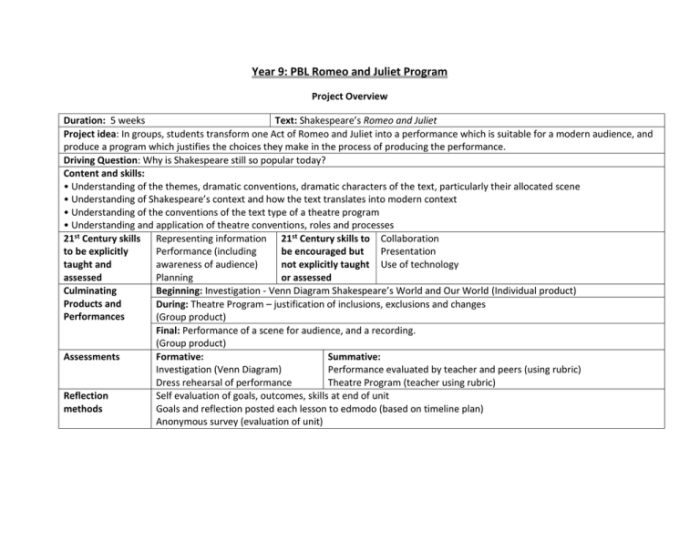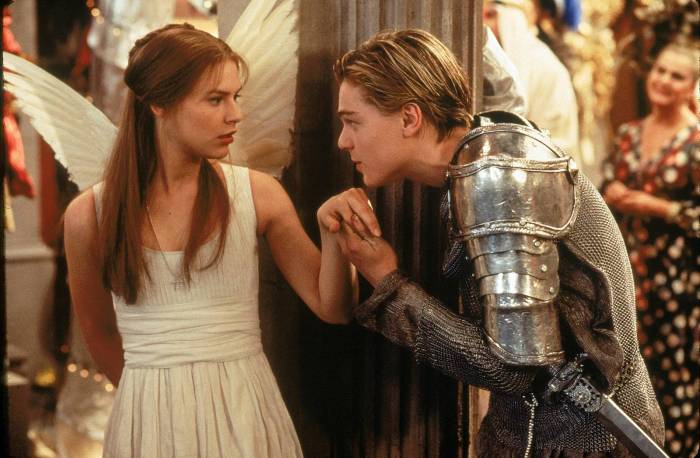Romeo and juliet: unit test – Embark on an exciting journey through Shakespeare’s timeless masterpiece, Romeo and Juliet, with our comprehensive unit test guide. Dive into the depths of character analysis, plot intricacies, themes, language, and cultural significance, gaining a profound understanding of this beloved tragedy.
Character Analysis

Romeo and Juliet, a timeless masterpiece by William Shakespeare, delves into the complexities of human nature and the enduring power of love. At the heart of this tragic tale lie the titular characters, Romeo and Juliet, whose distinct personalities and motivations shape the course of events.
Romeo’s Character
Romeo Montague, a passionate and impulsive youth, is initially portrayed as a lovesick and idealistic dreamer. However, as the play progresses, he reveals a more nuanced and conflicted character. Driven by his intense emotions, Romeo acts rashly, often without considering the consequences.
- Motivations:Love, passion, and loyalty
- Personality Traits:Impulsive, romantic, idealistic
- Development:From a lovesick youth to a mature and responsible man
Juliet’s Character
Juliet Capulet, a young and innocent maiden, is forced to navigate the complexities of her family’s feud and her own burgeoning love for Romeo. Despite her youth, Juliet demonstrates a remarkable maturity and resilience.
- Motivations:Love, family, and freedom
- Personality Traits:Mature, intelligent, courageous
- Tragic Flaw:Her inability to reconcile her love for Romeo with her family’s expectations
Comparison and Contrast
Romeo and Juliet share a deep and passionate love, but their characters differ significantly. Romeo is impulsive and emotional, while Juliet is more mature and pragmatic. Both characters experience a profound transformation throughout the play, growing in both wisdom and responsibility.
- Similarities:Deep love, idealism, tragic fate
- Differences:Romeo’s impulsivity vs. Juliet’s maturity
- Development:Both characters undergo significant growth and change
Plot Summary and Structure
Romeo and Juliet, a timeless tragedy by William Shakespeare, unfolds a captivating tale of star-crossed lovers amidst the bitter feud between the Montagues and Capulets. The play’s intricate structure, foreshadowing, and dramatic irony weave a compelling narrative that culminates in a heart-wrenching climax.
Plot Summary
- The Montagues and Capulets, two noble families of Verona, engage in an ancient feud.
- Romeo Montague and Juliet Capulet meet at a masked ball and fall deeply in love.
- Despite their families’ animosity, Romeo and Juliet secretly marry with the help of Friar Laurence.
- Tybalt, Juliet’s cousin, kills Mercutio, Romeo’s friend, leading to Romeo killing Tybalt in revenge.
- The Prince banishes Romeo from Verona.
- Friar Laurence devises a plan to reunite Romeo and Juliet, but it goes awry due to miscommunication.
- Romeo believes Juliet is dead and drinks poison, while Juliet awakens to find Romeo dead beside her.
- In despair, Juliet takes her own life, and the feuding families are finally reconciled.
Structure
The play is divided into five acts, each building tension and foreshadowing the tragic outcome. The prologue sets the scene and introduces the feud between the Montagues and Capulets. The use of foreshadowing, such as the prophecy of the two households’ doom, creates a sense of impending tragedy.
Dramatic irony, where the audience knows more than the characters, heightens the emotional impact of the play. For instance, the audience is aware of Romeo and Juliet’s secret marriage while the feuding families remain oblivious.
Prologue and Epilogue
The prologue introduces the central conflict and sets the tone for the tragedy. It foreshadows the impending doom of the two lovers and highlights the futility of their love amidst the feud.
The epilogue serves as a lament for the young lovers and a call for reconciliation. It emphasizes the devastating consequences of hatred and the need for forgiveness and understanding.
Themes and Symbolism

At the heart of Romeo and Juliet lies a complex tapestry of themes and symbols that illuminate the play’s timeless relevance. These elements delve into the depths of human experience, exploring the transformative power of love, the inevitability of fate, and the devastating consequences of violence.
Love
- Love is a transformative force that can ignite passion, devotion, and selflessness. The play portrays love as a powerful emotion that can transcend social barriers and overcome obstacles.
- However, love can also be a source of great pain and suffering. Romeo and Juliet’s love is doomed from the start, as their families’ feud creates an insurmountable divide.
Fate
- The play explores the role of fate in shaping human destiny. Romeo and Juliet are caught in a web of circumstances beyond their control, and their tragic end seems inevitable from the beginning.
- The characters’ actions are often driven by forces beyond their understanding, leading to a sense of helplessness and despair.
Violence
- Violence is a destructive force that permeates the play, leaving a trail of death and devastation in its wake. The feud between the Montagues and Capulets escalates throughout the play, leading to numerous casualties.
- The play highlights the futility of violence and its devastating impact on individuals, families, and society as a whole.
Imagery of Light and Darkness
- Light and darkness are recurring symbols throughout the play, representing hope and despair, respectively.
- Romeo is often associated with light, while Juliet is associated with darkness. Their love is seen as a beacon of hope in the midst of the surrounding darkness.
Imagery of Flowers
- Flowers are used symbolically in the play to represent beauty, love, and innocence.
- The rose is a particularly potent symbol, associated with both love and death.
Imagery of Poison
- Poison is a recurring motif in the play, representing both physical and emotional harm.
- The poison that Romeo and Juliet consume is a powerful symbol of their tragic fate.
Setting in Verona
- The play is set in Verona, a city known for its beauty and romance.
- The setting contributes to the play’s atmosphere of passion and tragedy, and it also reflects the social and political tensions of the time.
Language and Style: Romeo And Juliet: Unit Test
Shakespeare’s use of language in Romeo and Julietis a masterpiece of literary craftsmanship. His vocabulary is rich and varied, drawing upon both common and elevated speech, creating a sense of both realism and grandeur.
After you’ve wrapped up your Romeo and Juliet unit test, you might want to check out the Saxon Math 8 7 answer key to see how your math skills stack up. Then, you can come back to the Romeo and Juliet unit test and see how much you’ve improved.
The play’s imagery is equally impressive, evoking vivid sensory experiences that immerse the reader in the world of the play. From the “two households, both alike in dignity” to the “star-cross’d lovers,” Shakespeare’s imagery captures the essence of the story’s characters and conflicts.
Famous Speeches and Soliloquies
The play is renowned for its iconic speeches and soliloquies, which showcase Shakespeare’s mastery of language and his ability to convey complex emotions and ideas.
- Romeo’s “But soft, what light through yonder window breaks?”soliloquy expresses his newfound love for Juliet in a language that is both passionate and lyrical.
- Juliet’s “O Romeo, Romeo! Wherefore art thou Romeo?”speech captures her despair and longing for her beloved.
- Friar Laurence’s “These violent delights have violent ends”speech warns of the tragic consequences that await the lovers.
Character Language, Romeo and juliet: unit test
Shakespeare uses language to differentiate between his characters, reflecting their personalities and backgrounds.
- Romeospeaks in a romantic and idealistic manner, using flowery language and metaphors.
- Julietis more pragmatic and down-to-earth, but her language is still passionate and lyrical.
- Friar Laurenceis a wise and learned man, and his language is often philosophical and reflective.
Cultural and Historical Context

Romeo and Juliet was written during the Elizabethan era, a time of significant cultural and historical change. The play reflects the influence of Italian Renaissance literature and the rise of humanism, which emphasized the importance of individual experience and expression.
The play’s themes of love, fate, and violence resonate with contemporary audiences, as they continue to explore the complexities of human relationships and the impact of societal pressures.
Adaptations and Interpretations
Romeo and Juliet has been adapted into numerous art forms, including film, theater, and opera. These adaptations have reimagined the play’s characters and themes for different audiences and contexts.
- Film adaptations have ranged from classic versions like Franco Zeffirelli’s 1968 film to modern interpretations like Baz Luhrmann’s 1996 adaptation.
- Theater productions have experimented with different staging techniques and interpretations, such as the Royal Shakespeare Company’s 2016 production that set the play in a modern-day Verona.
- Operatic adaptations, such as Vincenzo Bellini’s 1830 opera I Capuleti e i Montecchi, have showcased the play’s musicality and dramatic potential.
FAQ Guide
What is the main conflict in Romeo and Juliet?
The main conflict is the feud between the Montague and Capulet families, which leads to tragic consequences for the young lovers.
What are the key themes explored in the play?
The play explores themes such as love, fate, destiny, violence, and the consequences of rash actions.
How does Shakespeare use language to convey the characters’ emotions?
Shakespeare uses a rich and poetic language, including metaphors, similes, and imagery, to express the characters’ inner thoughts and feelings.